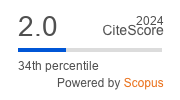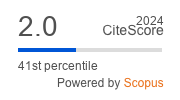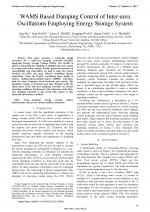| 2/2012 - 6 |
WAMS Based Damping Control of Inter-area Oscillations Employing Energy Storage SystemMA, J. |
| Extra paper information in |
| Click to see author's profile in |
| Download PDF |
Author keywords
damping, energy storage, phasor measurement units, power system stability, robustness
References keywords
power(27), systems(8), control(8), tpwrs(7), system(7), stability(6), energy(6), area(6), wide(5), interval(5)
Blue keywords are present in both the references section and the paper title.
About this article
Date of Publication: 2012-05-30
Volume 12, Issue 2, Year 2012, On page(s): 33 - 40
ISSN: 1582-7445, e-ISSN: 1844-7600
Digital Object Identifier: 10.4316/AECE.2012.02006
Web of Science Accession Number: 000305608000006
SCOPUS ID: 84865283884
Abstract
This paper presents a systematic design procedure for a wide-area damping controller (WADC) employing Energy Storage Systems (ESSs). The WADC is aimed at enhancing the damping of multiple inter-area modes in a large scale power system. Firstly, geometric measures of controllability and obsevability are used to select the control locations for ESSs and most effective stabilizing signals, respectively. Then, the WADC coordinates these signals to achieve multiple-input-multiple-output (MIMO) controllers with the least Frobenius norm feedback gain matrix. The simulation results of frequency and time domains verify the effectiveness of the wide-area damping controller for various operating conditions. Furthermore, the robustness of the wide-area damping controller is also tested with respect to time delay and uncertainty of models. |
| References | | | Cited By |
Web of Science® Times Cited: 3 [View]
View record in Web of Science® [View]
View Related Records® [View]
Updated today
SCOPUS® Times Cited: 3
View record in SCOPUS® [Free preview]
View citations in SCOPUS® [Free preview]
[1] Power System Event Ranking Using a New Linear Parameter-Varying Modeling with a Wide Area Measurement System-Based Approach, Abolhasani Jabali, Mohammad, Kazemi, Mohammad, Energies, ISSN 1996-1073, Issue 8, Volume 10, 2017.
Digital Object Identifier: 10.3390/en10081088 [CrossRef]
[2] Design and Optimization of Fractional Order PID Controller to Enhance Energy Storage System Contribution for Damping Low-Frequency Oscillation in Power Systems Integrated with High Penetration of Renewable Sources, Abumeteir, Hasan Ali, Vural, Ahmet Mete, Sustainability, ISSN 2071-1050, Issue 9, Volume 14, 2022.
Digital Object Identifier: 10.3390/su14095095 [CrossRef]
[3] A Model-trajectory-based Method for Analyzing the Time-varying Oscillation Characteristics of a Fault System, Ma, Jing, Li, Yinan, Liu, Chang, Qiu, Yang, Electric Power Components and Systems, ISSN 1532-5008, Issue 7, Volume 43, 2015.
Digital Object Identifier: 10.1080/15325008.2014.1003158 [CrossRef]
Disclaimer: All information displayed above was retrieved by using remote connections to respective databases. For the best user experience, we update all data by using background processes, and use caches in order to reduce the load on the servers we retrieve the information from. As we have no control on the availability of the database servers and sometimes the Internet connectivity may be affected, we do not guarantee the information is correct or complete. For the most accurate data, please always consult the database sites directly. Some external links require authentication or an institutional subscription.
Web of Science® is a registered trademark of Clarivate Analytics, Scopus® is a registered trademark of Elsevier B.V., other product names, company names, brand names, trademarks and logos are the property of their respective owners.
Faculty of Electrical Engineering and Computer Science
Stefan cel Mare University of Suceava, Romania
All rights reserved: Advances in Electrical and Computer Engineering is a registered trademark of the Stefan cel Mare University of Suceava. No part of this publication may be reproduced, stored in a retrieval system, photocopied, recorded or archived, without the written permission from the Editor. When authors submit their papers for publication, they agree that the copyright for their article be transferred to the Faculty of Electrical Engineering and Computer Science, Stefan cel Mare University of Suceava, Romania, if and only if the articles are accepted for publication. The copyright covers the exclusive rights to reproduce and distribute the article, including reprints and translations.
Permission for other use: The copyright owner's consent does not extend to copying for general distribution, for promotion, for creating new works, or for resale. Specific written permission must be obtained from the Editor for such copying. Direct linking to files hosted on this website is strictly prohibited.
Disclaimer: Whilst every effort is made by the publishers and editorial board to see that no inaccurate or misleading data, opinions or statements appear in this journal, they wish to make it clear that all information and opinions formulated in the articles, as well as linguistic accuracy, are the sole responsibility of the author.



